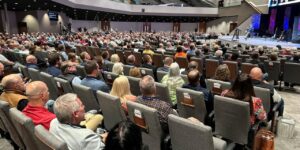
Paul E. Miller, the author of A Praying Life, has led more than 500 church prayer conferences. He estimates that 90 percent of evangelical churches do not have what he calls “a functioning” prayer ministry. If his estimates are accurate (or even close), we all have work to do!
It’s impossible to imagine any church that doesn’t pray or believe in prayer. But are many churches “praying” churches? It’s unlikely that most of our churches have pressed deeply in to becoming houses of prayer. After all, prayer is not an easy ministry. Daniel Henderson, the prayer leader and author, reminds us that “Building a prayer culture takes time. . . and relentless pressure over time. I often say that it is much more a crock pot than a microwave.”
Leading a praying church requires intentional and frequently repeated steps to accomplish your goals. Here are five essential actions for building a powerful church prayer ministry.
The pastor a man of prayer
Most people don’t follow vision – they follow leaders with a vision. The evangelical world knows Brooklyn Tabernacle is a house of prayer for all nations. Yet, it wasn’t always a praying church.
In his book Fresh Wind Fresh Fire, the long-time pastor Jim Cymbala admits that in the early 1970s it was a dying church; and “more people were turning to crack than to Christ” in New York City. When he was ready to quit in discouragement, God spoke to him about leading the people to pray. Today, thousands of people have been blessed by the example and the ministry of Brooklyn Tabernacle that became a praying church when the pastor became a praying leader.
As E. M. Bounds wrote, “The Church is looking for better methods; God is looking for better men.” It is impossible to imagine a congregation becoming a praying church without a praying pastor.
Dynamic prayer meetings
Prayer meetings change the world! For too long we’ve endured dead, lifeless prayer meetings. Barely anyone attends, and they bear no resemblance to the powerful, Spirit-filled, dynamic, life-giving prayer meetings described in the book of Acts. Those early days are not gone forever. Jesus started the church the way He wanted it, now He wants the church the way He started it!
One focus for a dynamic prayer meeting is an atmosphere that invites the presence of God. Of course, God is omnipresent; but there is a distinction between God’s omnipresence and His manifest presence. The Scripture describes the desire for God’s manifest presence in verses like Psalm 63:1 where the psalmist “seeks” God because his dry soul longs for God’s presence. God is everywhere, but a sense of God’s presence revives us.
“O God, you are my God; earnestly I seek you;
my soul thirsts for you;
my flesh faints for you,
as in a dry and weary land where there is no water” (Psalm 63:1).
Our engagement in musical worship, our Scripture reading, our transparency in confession, the leaders’ humility, and a willingness to spend more time praying – rather than merely talking about prayer or making lists – can help create the Spirit-led, Scripture-fed atmosphere which invites the sense of God’s presence. If we make the manifest presence of God a measurement of a successful prayer meeting, we will probably walk away with a greater appreciation of the promise of Jeremiah 29:12-13:
“Then you will call upon me and come and pray to me, and I will hear you. You will seek me and find me, when you seek me with all your heart.”
Prayer training for the church
Charles Spurgeon once said, “I would rather teach one man to pray than ten men to preach.” Believers can and must learn to pray, and churches should offer training. Instruction in prayer is woven into the fabric of the Christian life. After all, even the disciples asked Jesus to teach them to pray (Luke 11:1).
Every church needs to offer prayer training to at least two groups. First, we equip those who pray over the prayer requests received by the church. These praying volunteers also help administrate the “mechanics” of the prayer ministry.
The second group needing prayer training is the church family itself. Every member should receive at least one opportunity a year to receive comprehensive prayer training. Building a praying church means training those who pray!
Plan for receiving and praying over requests
How many ways can a person submit a prayer request at your church? Do you have a plan for increasing that number? Can they submit requests at church? Can they submit requests online? Do you have a prayer line they can call? Can they text their request? Is there a QR code made available? Is there a physical place to drop off requests? How do you make people aware of these opportunities? Who retrieves the requests? Where do the requests go once they’re received? How long do you retain them? Who prays over them? How are the requests circulated to a larger or remote prayer team? Who is responsible for distributing the requests to the team? Is there a process for recruiting additional volunteers? How confidential are the requests? Does the church respond to any of them? How do you respond? Has one prayer coordinator been appointed to oversee all the logistics and the other volunteers? There are multiple moving parts that are essential components for an effective church prayer ministry.
Church wide prayer challenges
Obedience is contagious in the Christian life. There is power in positive peer reinforcement in the ministry of prayer. Churches that challenge the entire church to pray in a special challenge will inevitably increase the congregation’s vision and belief about the power of prayer. We grow better when we grow together.
For example, several churches start the new year with 21 days of prayer and fasting. Some churches dedicate at least one Sunday morning annually to a congregational prayer service. Special calls to prayer leading up to evangelistic services, mission trips or offerings, or when seeking God’s specific direction for the future lift the congregational understanding and dependence upon prayer. Every praying church will plan some annual congregational calls to prayer.
Prayer connects us to God. A praying church, therefore, will connect its people to prayer.















